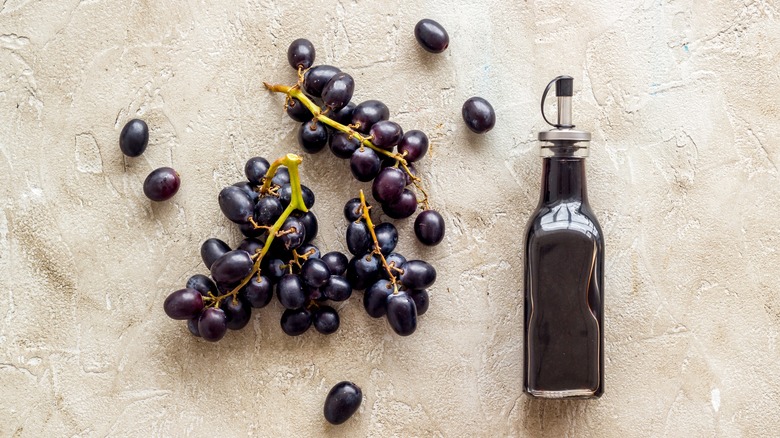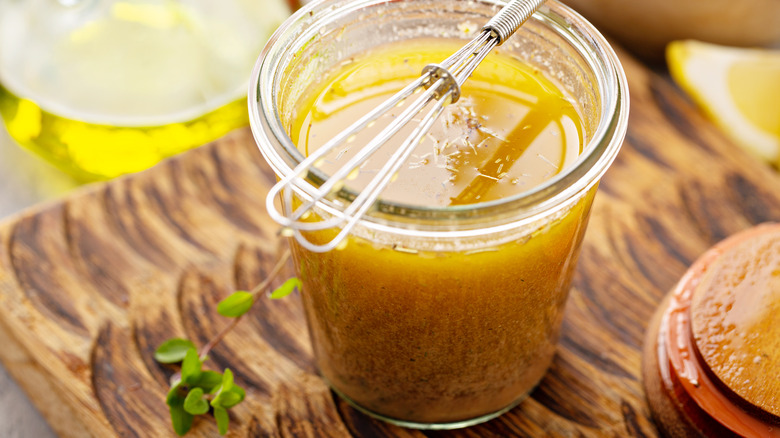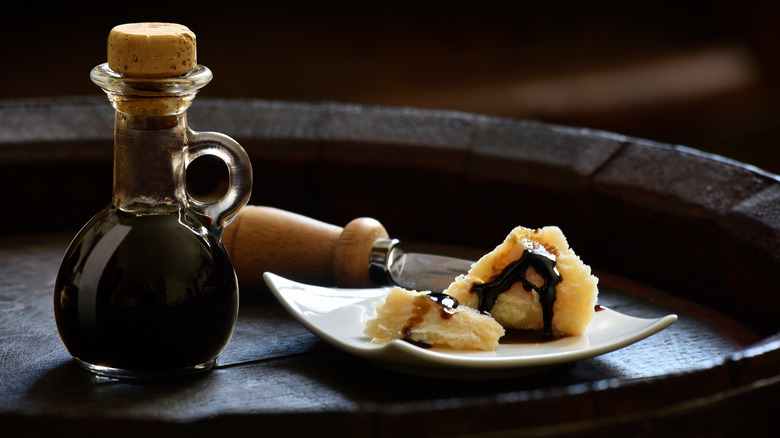The Difference Between Red Wine Vinegar And Balsamic Vinegar
Some ingredients are so essential to cooking that it's hard to fathom life without them. One mega-popular ingredient we sometimes take for granted is the grape, with its sweet, nuanced flavor. We eat the fruits, process them into jam, jelly, and raisins (not to mention juice and wine), and we use them as ingredients in mainstream products such as A1 steak sauce (per Kraft Heinz).
From there, we also use grapes to craft several types of vinegar, including red wine vinegar and balsamic vinegar, which isn't made from balsam. (Britannica describes balsam as resin that comes from plants and smells good enough to be used as incense and medicine since ancient times.) Vinegar may be ages-old, but there are plenty of fresh ways to use it to make your recipes shine.
You likely already have both of these types of vinegar in your pantry. Here's what differentiates them and how to use them effectively in your cooking.
Balsamic vinegar vs. red wine vinegar
While both red wine vinegar and balsamic vinegar are derived from grapes, the two ingredients could not be more different. Red wine vinegar comes from red wine that's aged no more than two years (per Spiceography). As such, it looks drastically different from balsamic vinegar. It's thinner, with a transparent, purplish-red color and a sprightlier flavor. Toss salads and veggies in it — think slaw and other mild, cold dishes where its sharpness will be appreciated. Red wine vinegar plays nicely with citrus, as demonstrated in preparations like mandarin cranberry chutney, which is perfect with pork, chicken, and turkey. Webstaurant Store praises it in mignonette, a tart topping for raw shellfish.
Authentic balsamic vinegar, writes MasterClass, comes from the juice of whole grapes, concentrated and fermented. Balsamic vinegar is dark and opaque or close to it, often with a thicker texture than red wine vinegar. It has savory, fruity, and umami undertones.
Because of this delicate nature, balsamic vinegar is more of a condiment than an additive. It's necessary for a show-stopping Caprese salad, and it makes a killer steak marinade, per The New York Times. Put its deep, rich flavor to work in caper-raisin relish or homemade vinaigrette, or drizzle it on artisan cheese or fruits, as in this balsamic and black pepper strawberries recipe. Or, you can simply enjoy balsamic vinegar by blending it with olive oil and herbs to bathe crusty bread in.
Humans have always loved vinegar
Vinegar is a near-universal baseline for embodying the "sour" taste, and that's because it's made by fermentation of fruit, grains, or alcoholic products into a liquid that includes acetic acid, Britannica explains. According to the Harvard T.H. Chan School of Public Health, the word vinegar comes from French for "sour wine," and it's been dated back to 5000 B.C.E. Babylon, where it was used for its purported medicinal qualities as well its gastronomical appeal.
While Harvard explains that vinegar may have been accidentally invented by letting wine go for far too long, its use is anything but a mistake. The high acidity of vinegar makes it a versatile cooking ingredient that alters texture (think marinades), balances flavors (in condiments and recipes), and aids in preservation (like in pickles), per Harvard. Vinegar is also useful as an all-natural cleaning product that can remove hard water stains, Harvard adds.
While a substance that helps clean your sink might not seem appetizing, vinegar has long been associated with possible health benefits. Harvard details its role as a tonic to improve digestion, address coughs, and prevent wound infection. And prebiotic varieties, such as apple cider vinegar, may be good for the gut, Harvard explains.


